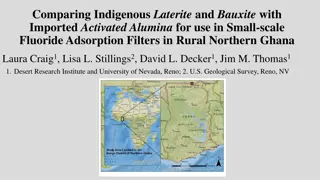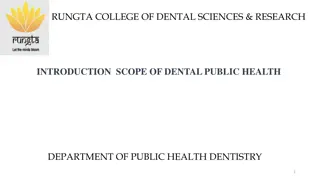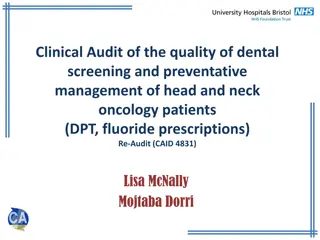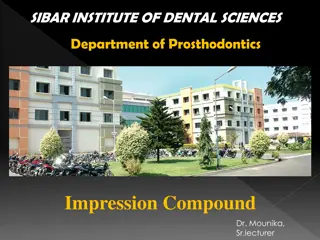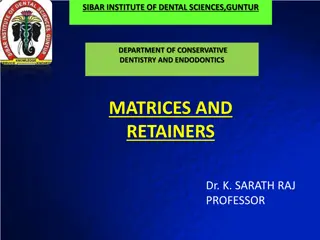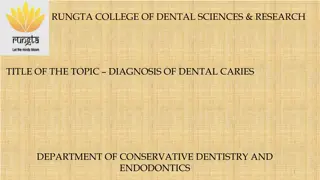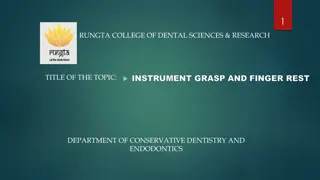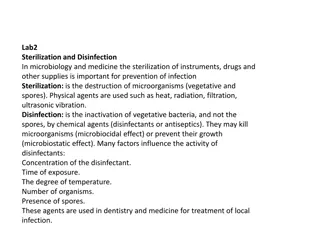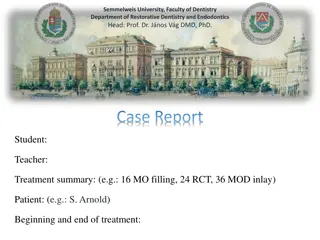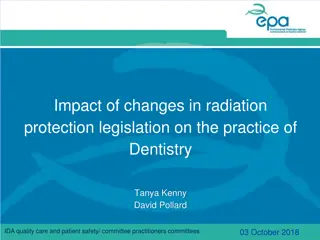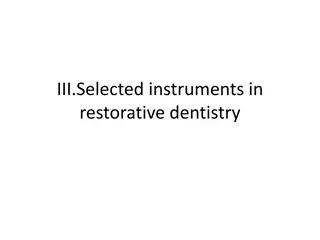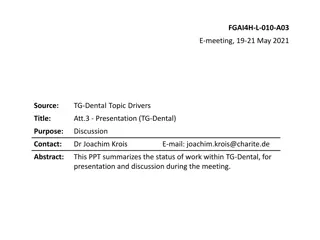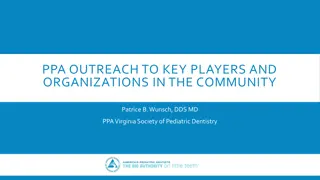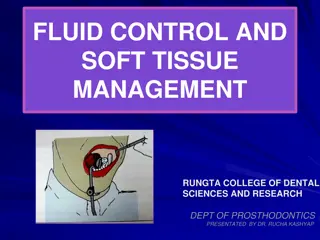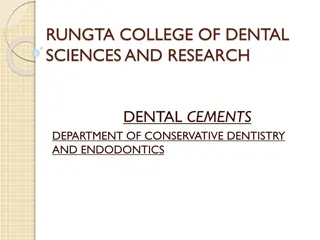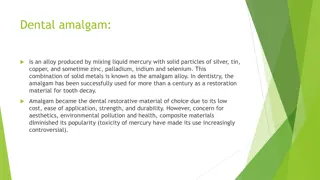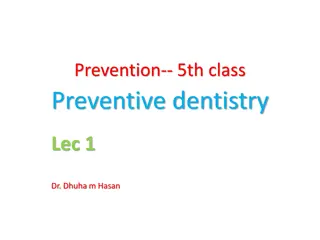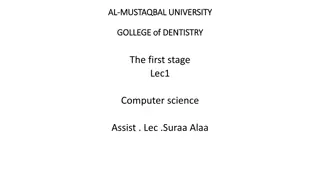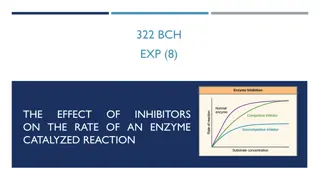Understanding the Role of Fluoride in Dentistry
The history of fluorides in dentistry dates back over 100 years. Fluoride, sourced mainly from water, has been integrated into various consumables to aid in preventing dental caries. It forms mineral complexes with cations and is found in minerals like fluorspar and apatite. Fluoride concentrations vary in water, vegetation, and sea water, impacting soil content and industrial processes. Understanding this element's presence in the environment is crucial for dental health and environmental considerations.
Uploaded on Oct 03, 2024 | 0 Views
Download Presentation

Please find below an Image/Link to download the presentation.
The content on the website is provided AS IS for your information and personal use only. It may not be sold, licensed, or shared on other websites without obtaining consent from the author. Download presentation by click this link. If you encounter any issues during the download, it is possible that the publisher has removed the file from their server.
E N D
Presentation Transcript
Fluoride in dentistry Dr. Rihab Abdul Hussein Ali B.D.S , M.Sc. , PhD.
The history of fluorides in dentistry is over 100 years old. Fluoride was isolated from water supplies in 1931 and has been incorporated into water, milk, salt, tablets, and drops. It has also been included as an active agent for the prevention of dental caries. The use of fluorides for dental purposes began in the nineteenth century. The detrimental effects of fluoride on the appearance of tooth enamel (dental fluorosis) that prompted the initial detailed investigations and ultimately the discovery of its anticaries benefits.
Water is by far the most common natural source of fluoride, but even in areas with levels of fluoride in the drinking water less than 0.5 0.7 mg/l, importation of commercially prepared beverages and other foods, from areas where water supplies contain higher levels, can add substantially to the amount of fluoride ingested. Fluorine is the lightest member of the halogen group and is one of the most reactive of all chemical elements (form salts of almost of all metals). It is not, therefore, found as fluorine in the environment (which is derived from a Latin word fluore that is to flow). It is the most electronegative of all the elements. Fluoride thus forms mineral complexes with a number of cations and some fairly common mineral species of low solubility contain fluoride.
Fluorine in the environment is therefore found as fluorides which together represent about 0.06 0.09per cent of the earth s crust. Fluorides are found at significant levels in a wide variety of minerals, including fluorspar (CaF2), rock phosphate, cryolite (Na3AlF6), apatite (Ca10(PO4)6F2) and others. In atmosphere; Fluoride is commonly associated with volcanic activity and their gases. It is originating from dusts of fluoride containing soils, gaseous industrial wastes.
In sea water, the fluoride concentration ranged 0.8- 1.4 ppm. While the concentration in vegetation is range from 2-20 ppm dry weight according to species of the plant, age of leafs, soils, fertilizers and pollution. Fluoride is return to soils through plant wastes or it may enter the food chain and be returned as animal s waste. Thermal waters, especially those of high pH, are also rich in fluoride. The fluoride salt cryolite is used for the production of aluminium and as apesticide. Rock phosphates are converted into phosphate fertilizers by the removal of up to 4.2 percent fluoride; the removed and purified fluoride (as fluorosilicates) is a source of fluoride that in some countries is added to drinking water in order to protect against dental caries.
Fluoride: Has beneficial effects on teeth at low concentrations in drinking-water. Excessive exposure to fluoride in drinking-water, or in combination with exposure to fluoride from other sources, can give rise to a number of adverse effects. These range from mild dental fluorosis to crippling skeletal fluorosis as the level and period of exposure increases. Crippling skeletal fluorosis is a significant cause of morbidity in a number of regions of the world. The caries preventive effect was demonstrated since 1930. Some studies reported that water fluoridation reduce dental caries by 50%.
Fluoride is expressed as part per million (ppm) which equal to 1 mg fluoride per liter of water (kilogram). Sources of fluoride in man involving water, food (breast milk F= 6-12mg/ml; cow s milk F <0.019ppm; tea F= 0.5-4ppm; fish and shell fish), drugs (diuretics and anesthetics) and dental products (as dentifrices and mouth rinses).
Fluoride metabolism Fluoride ingestion is particularly important in infants as dental fluorosis can only occur when teeth are developing. Fluoride is poorly transported from plasma to milk, even when the mother or animal has a high intake of fluoride Absorption Approximately 75 90% of ingested fluoride is absorbed. In an acidic stomach, fluoride is converted into hydrogen fluoride (HF) and up to about 40% of the ingested fluoride is absorbed from the stomach as HF. High stomach pH decreases gastric absorption by decreasing the concentration uptake of HF.
Relative to the amount of fluoride ingested, high concentrations of cations that form insoluble complexes with fluoride (e.g. calcium, magnesium and aluminium) can markedly decrease gastrointestinal fluoride absorption (70%) while in food rich calcium (60%). The time of fluoride ingestion in relation to meals is critical with respect to how much of the fluoride will become bioavailable.
Distribution Once absorbed into the blood, fluoride readily distributes throughout the body, with approximately 99% of the body burden of fluoride retained in calcium rich areas such as bone and teeth (dentine and enamel) where it is incorporated into the crystal lattice. In infants about 80-90% of the absorbed fluoride is retained but in adults this level falls to about 60%. Fluoride crosses the placenta is about 70% of that of maternal blood and is found in mother s milk at low levels essentially equal to those in blood.
Under certain conditions, plasma fluoride levels provide an indication of the level of fluoride in the drinking-water consumed. Water is the major source of fluoride intake, fasting plasma fluoride concentrations of healthy young or middle-aged adults expressed in micromoles per liter are roughly equal to the fluoride concentrations in drinking water expressed as milligrams per liter. Two forms of fluoride are present; the ionic form (free or in organic fluoride) and the non-ionic or bounded fluoride. The ionic form in hard and soft tissues is the most important to health and is directly related to the amount of fluoride intake. The peak plasma concentration usually occurs within 30-60 minutes then decreased after distribution in the body.
Levels of fluoride that are found in the bone vary with the part of the bone examined and with the age and gender of the individual. Bone fluoride is considered to be a reflection of long-term exposure to fluoride. In long bone, the higher concentration of fluoride is in the periosteal region with a slight increase in endosteal region. Cancellous bone has higher concentration of fluoride compared to compact bone. Thus, bone might be considered a fluoride reservoir that maintains the fluoride concentration in the body fluids between the periods that fluoride is not being ingested.
Fluoride in soft tissues depends on the pH of extracellular fluid as higher acidity increase fluoride ion exchange through tissue plasma. Therefore, alkalization of body fluid is the useful treatment of fluoride toxicity.
Excretion Fluoride is excreted primarily via urine. After entering the renal tubules about 10-90% of fluoride ions will be reabsorbed and return to the circulatory system. Urinary fluoride clearance increases with urine pH due to a decrease in the concentration of HF. Numerous factors (e.g. diet and drugs) can affect urine pH and thus affect fluoride clearance and retention. About 10% of fluoride is excreted by feces (either not absorbed or re-excreted into GIT). A few quantities of fluoride are removed by sweat, saliva, tears.
Fluoride uptake Ingestion of fluoride during period of tooth formation (pre-eruptive stage), it may cause changes in the tooth morphology and composition, as smaller more rounded cusps depth of teeth turns the more self-cleansing, also development of shallower occlusal grooves. Fluoride ion may replace the hydroxyl group of hydroxyl apatite crystal forming fluorapatite crystal. Ca10 (Po4)6(OH)2 +2F- Ca10 (Po4)6F2+2OH
Ingestion of fluoride in the pre-eruptive stage will allow the incorporation of fluoride in the whole enamel and dentin. This will increase the resistance against dental caries in addition reduces the progression of dental caries In post-eruptive stage, fluoride will react with the outer enamel surface to enhance remineralization, thus continual topical application of fluoride is needed from mouth rinses, teeth paste and others. Two types of reaction may develop and can initiated at any time of person life. Ca10 (PO4)6(OH)2 +20F- 10CaF2+6PO4-+2 OH- Ca10 (PO4)6(OH)2 +2F- Ca10 (PO4)6F2+2OH-
Fluoridated apatite and/or fluorapatite are generally found in the surface layers of enamel that contains high fluoride concentrations of fluoride. This can arise both during development and from topical exposure. Enamel is composed primarily (~95%) of hydroxyapatite (HA) crystals in which are substituted a number of other ions including fluoride. Ca10(PO4)6(OH)2 + Mg++ = magnesium whitlockite Ca10(PO4)6(OH)2+ CO = carbonated apatite
Fluoride concentrations in teeth Concentrations of fluoride in all mineralized tissues will vary depending on the actual fluoride intake and the length of time during which such an intake has taken place. In general, fluoride levels are greatest at the surface of any tissue since this part of the tissue has the closest proximity to the surrounding tissue fluid from which the fluoride is supplied.
The fluoride concentration of the enamel is highest at the surface, but it falls steeply within the outer 100 Mm. After this point, it remains fairly constant up to the enamel dentin junction. The fluoride concentration of dentin is generally higher than that of bulk enamel and usually increases deeper into the tooth. As dentin formation continues slowly throughout life, fluoride steadily accumulates at the dentin pulp surface. However, the concentration of fluoride at the outermost surface of the enamel is highly dependent on posteruptive changes and therefore it may be a poor indicator of fluoride exposure during the developmental period of the tooth.
Once the enamel is fully formed and mineralized the fluoride content in human enamel can only be permanently altered as a result of chemical traumas to the tooth (dental caries and erosions) or through mechanical abrasion. Unless chemical interactions take place with substantial fluctuations in pH over a prolonged period it is not easy to change significantly the fluoride content in the surface enamel even after several topical fluoride treatments.
However, the fluoride concentration in the surface layers increases whenever demineralization and remineralization processes are ongoing. This means that in cervical regions, where dental plaque accumulates, will gradually increase over time. It is also the reason why the surface zone covering a subsurface caries lesion contains significantly higher amounts of fluoride than the surrounding normal enamel fluoride concentrations.
Source of fluoride: The source is water, food, saliva, gingiva in addition to fluoride products. Fluoride accumulation in enamel is aided by plaque (0.01-50 ppm F), which itself accumulates fluoride that is applied topically. Low concentration of fluoride is present in saliva 1-2 micromol/L from water, food, dentifrices. The concentration of fluoride in saliva is two- third of plasma level.



